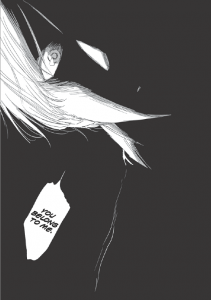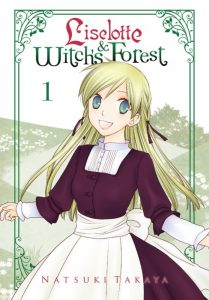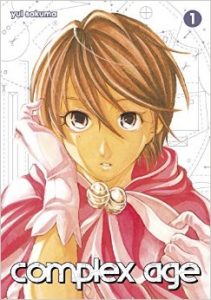By Mengo Yokoyari | Published by Yen Press
 I admit that I initially judged this book by its cover, assuming that it was on the smutty side and aimed at a decidedly male audience. While it is true that Scum’s Wish is seinen, the mangaka (Mengo Yokoyari) is female, and the end result (for me, at least) feels more like dark shoujo.
I admit that I initially judged this book by its cover, assuming that it was on the smutty side and aimed at a decidedly male audience. While it is true that Scum’s Wish is seinen, the mangaka (Mengo Yokoyari) is female, and the end result (for me, at least) feels more like dark shoujo.
Hanabi Yasuraoka has been in love with Narumi Kanai, a family friend, since she was little. He was around when her mother couldn’t be (Hanabi’s dad is out of the picture), and promised to always be there for her when she’s lonely. Now, Hanabi is in her second year of high school and Kanai has just started his first teaching job… as her homeroom teacher. Pretty quickly, he becomes smitten with another young teacher, pretty Akane Minagawa, and Yokoyari-sensei masterfully conveys through facial expressions just what Hanabi thinks about that. Soon, she meets Mugi Awaya, a boy who is in love with Minagawa (she used to be his tutor) and they strike up an odd sort of friendship as they hang out together, pining for their unrequited loves.
Eventually, through boredom, loneliness, and hormones, Hanabi and Mugi end up making out, each envisioning that the other is actually the one that they love. While there are a couple of bosom closeups during this part of the story, there are such complex emotions being felt in the scene that it doesn’t feel at all salacious. Ultimately, they decide to publicly become a couple so that they can fulfill each other’s physical desires as needed, though one of the rules they establish is that they won’t be having sex, so I’m assuming this arrangement leads to a great deal of frustration.
The concept of a young couple in a purely physical relationship reminded me of A Girl on the Shore, but happily there’s no disturbing power imbalance between Hanabi and Mugi. No one is merely accepting what they can get from someone who belittles them. They have a lot in common and there’s an inkling, too, that something more might develop (even though they made a rule forbidding that, too), with Hanabi thinking that Mugi has never let her down, unlike Kanai, and feeling possessive of him.
As the scope of the story widens, we meet other characters who are in love with the leads. In addition to a boy who hasn’t received a name yet, Hanabi’s admirers include a girl named Sanae Ebato, who appears for the duration of one chapter and has yet to be mentioned again. Mugi’s overly enthusiastic admirer is Noriko Kamomebata, who has worked very hard to become a princess worthy of him, and gives the impression of a newly hatched chick who imprinted on him.
The introduction of Noriko—who prefers the name Moka, for “most kawaii”—does lead to my one complaint about this volume. Although I’ve presented the story of Hanabi and Mugi in a linear fashion, it’s actually largely told through flashbacks. I followed all of these fine until Noriko is introduced, at which point she refers to herself and Mugi as both being first years. In the first chapter, though, Mugi and Hanabi are both confirmed to be seventeen years old, they discuss their scores on a test, and Hanabi clearly mentions being in the second year of high school. So, is Mugi a second year like her or is he a first year? The timing of when Noriko arrives and objects to their relationship, therefore, is fuzzy and confusing.
All in all, though, Scum’s Wish was far better than I had originally assumed. I have no idea where the story will go from here, so I am very curious to see how it develops.
Scum’s Wish is ongoing in Japan and seven volumes are available so far. Yen Press will release volume two in English later this month.
Review copy provided by the publisher.

 Until Olivia mentioned it over in the
Until Olivia mentioned it over in the  I love series like this, where the leads have episodic disturbances that they investigate (via the partnership they strike up as a sort of supernatural cleaning crew and frequently assisting a non-believing cop named Hanzawa) plus an ongoing mystery (involving curses cast by someone named Erika Hiura) and yet the most important and fascinating aspect is the relationship between the leads themselves. There are the fun, suggestive moments where the guys are combining their powers for one reason or another and end up using dialogue like, “Do you want me to touch it?” or “Take me all the way in.” But where Yamashita-sensei really excels is at teasing out threads of darkness.
I love series like this, where the leads have episodic disturbances that they investigate (via the partnership they strike up as a sort of supernatural cleaning crew and frequently assisting a non-believing cop named Hanzawa) plus an ongoing mystery (involving curses cast by someone named Erika Hiura) and yet the most important and fascinating aspect is the relationship between the leads themselves. There are the fun, suggestive moments where the guys are combining their powers for one reason or another and end up using dialogue like, “Do you want me to touch it?” or “Take me all the way in.” But where Yamashita-sensei really excels is at teasing out threads of darkness.
 It’s only at the end of volume three, wherein Hiyakawa nonchalantly suggests that it’d be good if they could work the other side of the business, too, that Mikado realizes he has no idea what kind of person he’s working with. As a reader, I too was lulled into believing that of course the protagonist of a series about fighting the supernatural is a good guy. Turns out, he’s more of an empty-inside opportunist. At this point, even I just want to say, “Run away, Mikado! Run away and don’t look back!” Is there any hope that he can help heal and humanize Hiyakawa, or will he only end up destroyed? How soon until volume four comes out?!
It’s only at the end of volume three, wherein Hiyakawa nonchalantly suggests that it’d be good if they could work the other side of the business, too, that Mikado realizes he has no idea what kind of person he’s working with. As a reader, I too was lulled into believing that of course the protagonist of a series about fighting the supernatural is a good guy. Turns out, he’s more of an empty-inside opportunist. At this point, even I just want to say, “Run away, Mikado! Run away and don’t look back!” Is there any hope that he can help heal and humanize Hiyakawa, or will he only end up destroyed? How soon until volume four comes out?!
 After making a social blunder at school that results in being shunned by her female classmates, Komugi Kusunoki is glad of the chance to start over in Hokkaido when the demands of her mother’s job mean Komugi will need to live with her father instead. At Maruyama High School, she quickly befriends a couple of nice girls (Kana and Keiko) and learns about the small clique of hotties over whom many girls swoon but who keep to themselves. One day, she surprises one of the boys (Yu Ogami) while he is napping and he turns into a wolf who promptly boops her on the nose.
After making a social blunder at school that results in being shunned by her female classmates, Komugi Kusunoki is glad of the chance to start over in Hokkaido when the demands of her mother’s job mean Komugi will need to live with her father instead. At Maruyama High School, she quickly befriends a couple of nice girls (Kana and Keiko) and learns about the small clique of hotties over whom many girls swoon but who keep to themselves. One day, she surprises one of the boys (Yu Ogami) while he is napping and he turns into a wolf who promptly boops her on the nose.  As Komugi gets to know them better, she learns that Ogami is half human and was abandoned in the woods by his human mother. Although he doesn’t hate humans as Fushimi claims to do, and is in fact kind and sweet, he’s still determined that he is going to be the last of his line and that he won’t fall in love with anyone, which is a problem because it doesn’t take long for Komugi to fall for him. Meanwhile, Fushimi witnesses this happening and tries to spare her hurt, and when she’s later trying to acclimate to just being friends with Ogami, he’s the one who’s there for her to talk to, sparking some jealous feelings on Ogami’s part.
As Komugi gets to know them better, she learns that Ogami is half human and was abandoned in the woods by his human mother. Although he doesn’t hate humans as Fushimi claims to do, and is in fact kind and sweet, he’s still determined that he is going to be the last of his line and that he won’t fall in love with anyone, which is a problem because it doesn’t take long for Komugi to fall for him. Meanwhile, Fushimi witnesses this happening and tries to spare her hurt, and when she’s later trying to acclimate to just being friends with Ogami, he’s the one who’s there for her to talk to, sparking some jealous feelings on Ogami’s part. Seventeen-year-old Atsuko is desperate for cash. Her father is an ungrateful drunk, they’re so poor that she’s mocked by classmates for her lack of personal hygiene, and she has resorted to fleecing perverted old men just so she can eat. Shortly after a chance meeting in which she runs into her male doppelganger, Itaru, she is kidnapped by his rich friend, Ryo Sekiuchi, and hired to impersonate Itaru (who has gone missing) for one million yen. Atsuko agrees and tutoring commences. She meets some nice people who are concerned for her welfare and appreciative of her effort, which is something she hasn’t experienced before, and learns that happiness isn’t automatic, even if you live in a huge, beautiful mansion.
Seventeen-year-old Atsuko is desperate for cash. Her father is an ungrateful drunk, they’re so poor that she’s mocked by classmates for her lack of personal hygiene, and she has resorted to fleecing perverted old men just so she can eat. Shortly after a chance meeting in which she runs into her male doppelganger, Itaru, she is kidnapped by his rich friend, Ryo Sekiuchi, and hired to impersonate Itaru (who has gone missing) for one million yen. Atsuko agrees and tutoring commences. She meets some nice people who are concerned for her welfare and appreciative of her effort, which is something she hasn’t experienced before, and learns that happiness isn’t automatic, even if you live in a huge, beautiful mansion. In the immortal words of Sir Paul McCartney:
In the immortal words of Sir Paul McCartney: On the one hand, it’s exciting to be reading something new by Natsuki Takaya, creator of my beloved Fruits Basket. On the other, it was kind of weird to embark upon an unfamiliar story whose artistic style was so very familiar to me.
On the one hand, it’s exciting to be reading something new by Natsuki Takaya, creator of my beloved Fruits Basket. On the other, it was kind of weird to embark upon an unfamiliar story whose artistic style was so very familiar to me.
 In the kingdom of Kohka, kindly King Il adores his only child, Princess Yona, and throws a celebration for her sixteenth birthday. Red-haired Yona is primarily preoccupied with getting her cousin, Su-Won, to see her as a woman. After the festivities, she decides to go tell her father that she simply must be allowed to marry Su-Won, only to walk in on her beloved running her father through with a sword. The palace guards are in on the treachery, and ready to comply with Su-Won’s order to dispatch the witness, but Yona is saved by her trusty personal guard, Hak, and the two of them manage to escape.
In the kingdom of Kohka, kindly King Il adores his only child, Princess Yona, and throws a celebration for her sixteenth birthday. Red-haired Yona is primarily preoccupied with getting her cousin, Su-Won, to see her as a woman. After the festivities, she decides to go tell her father that she simply must be allowed to marry Su-Won, only to walk in on her beloved running her father through with a sword. The palace guards are in on the treachery, and ready to comply with Su-Won’s order to dispatch the witness, but Yona is saved by her trusty personal guard, Hak, and the two of them manage to escape. I’m interested in a couple of the villainous characters, too! Kang Tae-jun of the fire tribe has desired Yona for a long time, so his remorse at her apparent death is genuine, even if he’s an entitled jerk. He reminds me of Skip Beat!’s Sho, a little bit, and I have a strong desire to see him switch sides someday and become a better person. And then there’s Su-Won, who ends the volume believing that Yona’s dead and being crowned king even as he admits that he crushed his dearest friends underfoot to achieve it. That’s much more interesting than him being utterly evil, and I wonder if he was manipulated into believing King Il had murdered his father or if that’s actually true. Unfortunately, both of these guys are more interesting to me right now than Hak is. Hopefully that will change.
I’m interested in a couple of the villainous characters, too! Kang Tae-jun of the fire tribe has desired Yona for a long time, so his remorse at her apparent death is genuine, even if he’s an entitled jerk. He reminds me of Skip Beat!’s Sho, a little bit, and I have a strong desire to see him switch sides someday and become a better person. And then there’s Su-Won, who ends the volume believing that Yona’s dead and being crowned king even as he admits that he crushed his dearest friends underfoot to achieve it. That’s much more interesting than him being utterly evil, and I wonder if he was manipulated into believing King Il had murdered his father or if that’s actually true. Unfortunately, both of these guys are more interesting to me right now than Hak is. Hopefully that will change.



Recent Comments